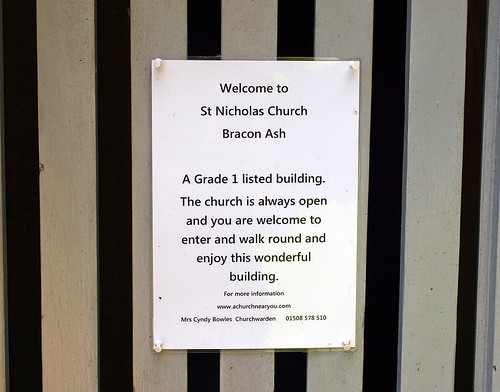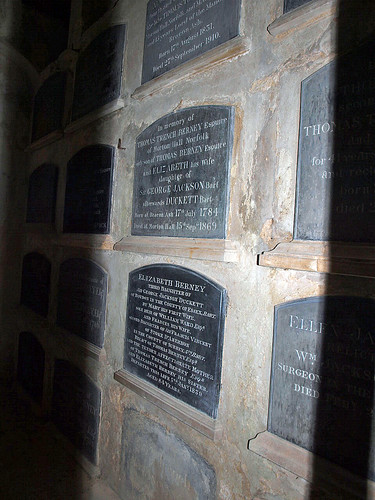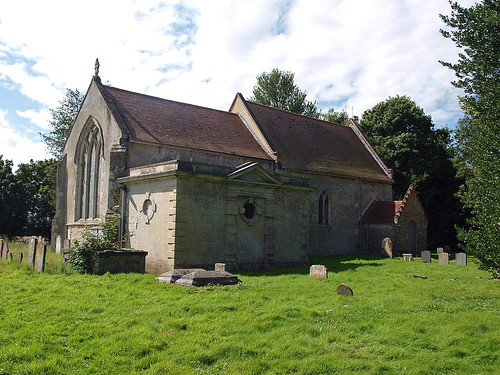Whilst I didn't add any new leads I did get to record the extant Weld monuments in this curiously attractive church. I say curiously because it shouldn't really work - early nave and chancel, mostly rendered, with a Georgian vault and a curious porch and a lost bellcote should equal an architectural disaster but actually looks quirky but in a good way. Externally I was reminded of Wimbish whilst the internal light brought to mind Tilty, both in Essex, although both are very different buildings.
The Berney vault is, in a somewhat macabre way, fascinating but subtler than the in your face Hatton equivalent at Long Stanton - personally I prefer the Berners style.
ST NICHOLAS. Nave and chancel. W of the S doorway a frame for one bell with a gabled roof over. The N porch with stepped gable may be of the early C19. In the S aisle two Dec windows. The S arcade, of three bays, has piers with polygonal projections and double hollow-chamfered arches. The chancel is a fine piece of late C13 work, which the over-restored windows (Y- and intersected tracery) do not betray. But inside the windows are shafted, and there was a curiously close group of them on the N side, now blocked by the addition in the C18 of the Bemey MAUSOLEUM. This is quite a stately, if ponderous, affair to the outside, quoined and with a pedimented middle bay flanked by intermittently blocked pilasters. Blocked circular windows with four heavy keystones. - ROYAL ARMS of George III in a frame of pilasters and pediment. - PLATE. Pre-Reformation Paten; Chalice (Norwich) 1567-8 ; Paten (London) 1819. - MONUMENT. The door to the Berney Mausoleum is now surrounded by the front of an Early Renaissance monument of terracotta, without doubt the work of the same craftsman who did the Bedingfeld Monuments at Oxborough. Baluster-pilasters, little pendants, and delicately detailed panels.
BRACON ASH. Its cream-walled cottages with thatched and tiled roofs stand by the roadside, not far from the towerless church hiding modestly among the trees. Bracon Hall in the park is a modern house on the site of one where Queen Elizabeth is said to have stayed; it has belonged to the Berneys for centuries. On the other side of the village is the fine old Mergate Hall which belonged to the Kemps for about 500 years.
Three arches on clustered pillars divide the 15th-century nave and aisle of the church; the chancel is older, and we can imagine its beauty as the builders left it 600 years ago, for here still are the remains of their fine windows, which had shafts on each side and heads and flowers between their arches. The ancient font and the winding rood stairway remain.
In this village was born a bad boy who became Lord Chancellor of England without greatly improving his character. He was the first Lord Thurlow. As his father could not manage him at home he was put in charge of a schoolmaster, who, however, could do nothing with him, and to whom he said on meeting him in later life, “I am not bound to recognise every scoundrel that recognises me.” That was the sort of man he was, in spite of the fact that in a solicitor’s oflice at Ely Place he found himself working with the gentle William Cowper. His chance at the Bar came with a wonderful speech he made in a famous case. He was a great success in the courts and succeeded in reversing a decision of the great Lord Mansfield on copyright. He had a long career also in Parliament, but was untrustworthy and eventually alienated most of his friends. He fought a duel in Hyde Park. He built a mansion at Dulwich, but never entered it because of a quarrel with the architect. He was blunt and vulgar, and could weep whenever it was necessary. He was lazy, and relied on others to prime him for his speeches and arguments. He hated change and believed in the royal prerogative. He thought foreign affairs so dull that he went to sleep at Cabinet Councils when they were being discussed. And yet he was a clever man. Dr Johnson enjoyed his conversation, but Charles James Fox declared that no man ever was so wise as Thurlow looked.
Three arches on clustered pillars divide the 15th-century nave and aisle of the church; the chancel is older, and we can imagine its beauty as the builders left it 600 years ago, for here still are the remains of their fine windows, which had shafts on each side and heads and flowers between their arches. The ancient font and the winding rood stairway remain.
In this village was born a bad boy who became Lord Chancellor of England without greatly improving his character. He was the first Lord Thurlow. As his father could not manage him at home he was put in charge of a schoolmaster, who, however, could do nothing with him, and to whom he said on meeting him in later life, “I am not bound to recognise every scoundrel that recognises me.” That was the sort of man he was, in spite of the fact that in a solicitor’s oflice at Ely Place he found himself working with the gentle William Cowper. His chance at the Bar came with a wonderful speech he made in a famous case. He was a great success in the courts and succeeded in reversing a decision of the great Lord Mansfield on copyright. He had a long career also in Parliament, but was untrustworthy and eventually alienated most of his friends. He fought a duel in Hyde Park. He built a mansion at Dulwich, but never entered it because of a quarrel with the architect. He was blunt and vulgar, and could weep whenever it was necessary. He was lazy, and relied on others to prime him for his speeches and arguments. He hated change and believed in the royal prerogative. He thought foreign affairs so dull that he went to sleep at Cabinet Councils when they were being discussed. And yet he was a clever man. Dr Johnson enjoyed his conversation, but Charles James Fox declared that no man ever was so wise as Thurlow looked.



No comments:
Post a Comment